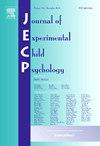Young children’s updating of mental representations of story characters and events based on verbal and pictorial information
IF 1.8
2区 心理学
Q3 PSYCHOLOGY, DEVELOPMENTAL
引用次数: 0
Abstract
The ability to create mental models of story events is essential for narrative comprehension, yet little is known about the mechanisms that support children’s ability to build and update an integrated mental representation of a story (a ‘situation model’) as it unfolds. The current study investigated very young children’s ability to update their situation model of a simple story from verbal and pictorial information about a physical event, manipulating both the explicitness of verbal information and the informativeness (Study 1) and presence (Study 2) of pictorial information. Sixty-four 2-year-olds (35 girls) and 67 3-year-olds (36 girls) participated in Study 1, and 119 2-year-olds (69 girls) and 81 3-year-olds (43 girls) participated in Study 2. Two- and 3-year-olds updated their mental representation of the physical state of the story protagonist at a rate above chance, regardless of the informativeness of an accompanying picture (Study 1) and the explicitness of verbal information provided (Study 2). However, children’s age in months significantly predicted 2-year-olds’ performance across studies, and in the absence of a picture, 3-year-olds performed less robustly when receiving implicit than when receiving explicit verbal information. Findings suggest that 2- and 3-year-olds can integrate implicit information into their situation model of a story, even when the accompanying pictorial information is not maximally informative, but that implicit verbal information embedded in a narrative presents challenges for young children’s updating when provided without pictorial support.
幼儿基于语言和图像信息对故事人物和事件的心理表征的更新
建立故事事件心理模型的能力对于叙事理解至关重要,然而,随着故事的展开,支持儿童建立和更新故事综合心理表征能力(“情境模型”)的机制却鲜为人知。本研究调查了幼童从一个物理事件的口头和图像信息中更新其简单故事情境模型的能力,同时操纵口头信息的显性性、信息性(研究1)和图像信息的存在性(研究2)。研究1中有64名2岁儿童(35名女孩)和67名3岁儿童(36名女孩)参加,研究2中有119名2岁儿童(69名女孩)和81名3岁儿童(43名女孩)参加。两岁和三岁的孩子以高于偶然的速度更新他们对故事主角身体状态的心理表征,而不考虑附带图片的信息量(研究1)和所提供的口头信息的明确性(研究2)。然而,在所有研究中,儿童的月龄显著地预测了2岁儿童的表现,并且在没有图片的情况下,3岁儿童在接受隐性语言信息时的表现不如接受显性语言信息时的表现强劲。研究结果表明,2岁和3岁的儿童可以将内隐信息整合到他们的故事情境模型中,即使伴随的图像信息不能最大限度地提供信息,但在没有图像支持的情况下,叙事中嵌入的内隐口头信息对幼儿的更新提出了挑战。
本文章由计算机程序翻译,如有差异,请以英文原文为准。
求助全文
约1分钟内获得全文
求助全文
来源期刊

Journal of Experimental Child Psychology
Multiple-
CiteScore
4.50
自引率
7.70%
发文量
190
期刊介绍:
The Journal of Experimental Child Psychology is an excellent source of information concerning all aspects of the development of children. It includes empirical psychological research on cognitive, social/emotional, and physical development. In addition, the journal periodically publishes Special Topic issues.
 求助内容:
求助内容: 应助结果提醒方式:
应助结果提醒方式:


